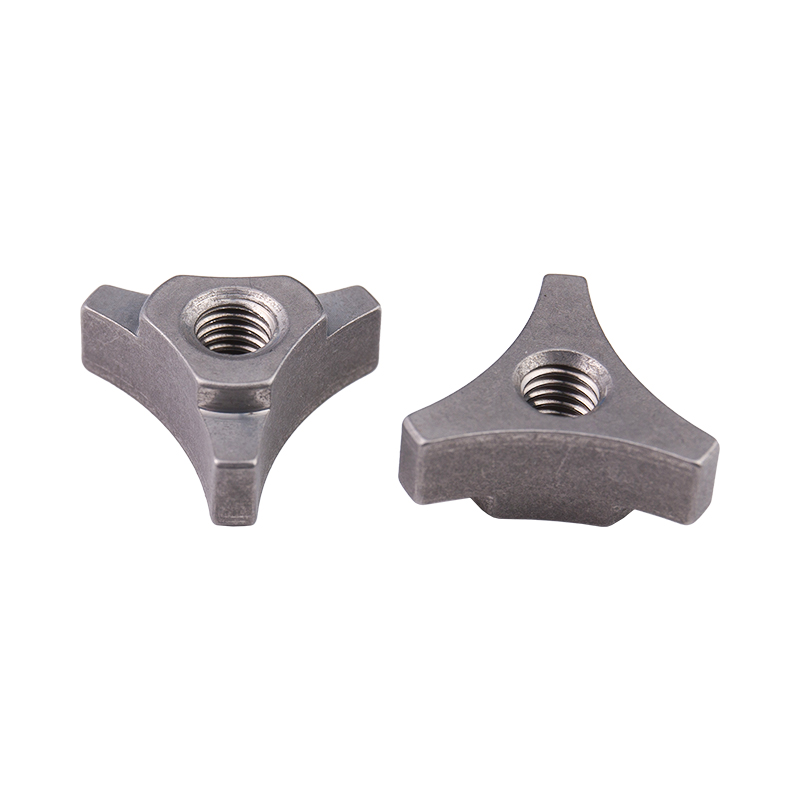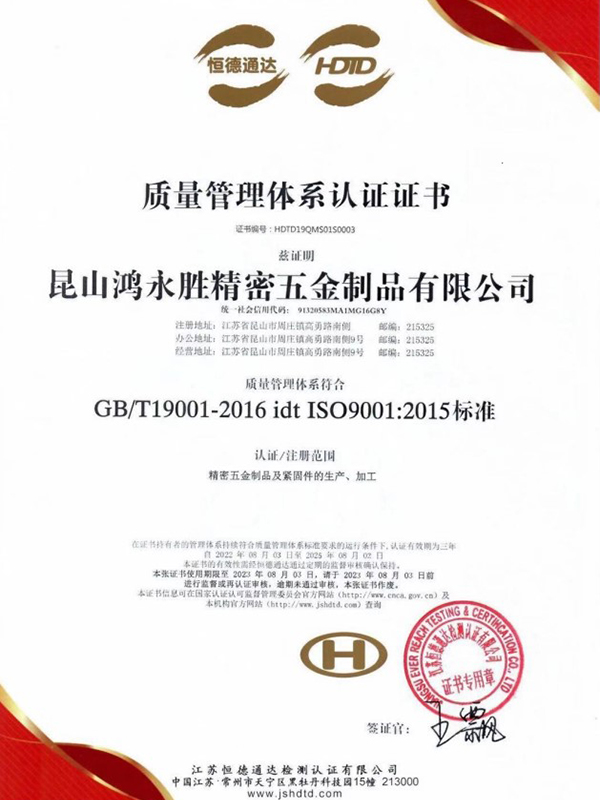Carbon Steel Bolt Supplier Guide: What Buyers Should Look For Selecting the right supplier for carbon steel bolts affects product performance, safety, and long-term cost. This guide breaks down the p...
READ MOREThe company has obtained two quality system management certificates of ISO9001:2015 and IATF16949:2016.
At present, the company has been for Japan, Sweden, the United States, Singapore, Malaysia, Hong Kong and the Pearl River Delta and many other customers to provide services, now the main customers are: Japan Sharp (SHARP), Japan SMC, Japan Panasonic (Panasonic), the Swedish automobile VOVOL, etc., all the fixed assets investment of more than 30 million dollars, welcome friends from all walks of life to the factory to visit, study, consulting and come! We welcome friends from all walks of life to visit our factory, investigate, consult and come to us for sample processing.
We are looking forward to establishing a good business partnership with you with mutual trust and reciprocity!
-
-
Introduction: The Foundation of Mechanical Systems In the intricate world of modern manufacturing and engineering, machined parts form the fundamental building blocks of virtually every mechanical sys...
READ MORE -
Why Structural Integrity Matters In construction, machinery, and other industrial applications, structural integrity is crucial for safety, performance, and longevity. One of the key elements in ensur...
READ MORE -
Introduction to Stainless Steel Fasteners Stainless steel fasteners are widely used in construction, machinery, and industrial applications due to their corrosion resistance and durability. Among them...
READ MORE
How does the composition of a copper hydraulic valve adjusting nut affect compatibility with different hydraulic oils?
The composition of a copper hydraulic valve adjusting nut can significantly impact its compatibility with different hydraulic oils.
Copper alloys, such as bronze or brass, are commonly used in hydraulic systems due to their corrosion resistance and mechanical properties. The composition of these alloys, including the presence of additional elements like tin, zinc, or aluminum, can influence their compatibility with various hydraulic oils.
Copper alloys with higher levels of tin, such as phosphor bronze, exhibit excellent resistance to corrosion from hydraulic fluids containing additives like anti-wear agents or rust inhibitors. This makes them suitable for applications where hydraulic oils with a wide range of additives are used.
Brass alloys, which typically contain zinc, offer good compatibility with many hydraulic oils but may be susceptible to dezincification in environments with high levels of acidity or alkalinity. Manufacturers may employ dezincification-resistant brass compositions to mitigate this risk.
The presence of aluminum in certain copper alloys can enhance their resistance to corrosion from water-based hydraulic fluids, such as water-glycol mixtures. Aluminum-bronze alloys, for example, are known for their durability in such applications.
Copper alloys can also be tailored through heat treatment or alloying additions to improve their resistance to specific chemicals or environmental conditions present in hydraulic oils. For instance, precipitation-hardened copper alloys can offer enhanced strength and corrosion resistance in harsh operating environments.
It's important for manufacturers to consider the potential interactions between the hydraulic fluid and the copper alloy, as well as any sealing materials or coatings used in the valve assembly. Compatibility testing may be conducted to ensure that the chosen copper alloy will maintain its integrity and performance over the lifespan of the hydraulic system.
The composition of the copper alloy in a hydraulic valve adjusting nut plays a crucial role in determining its compatibility with different hydraulic oils, and careful selection based on the specific application requirements is essential to ensure optimal performance and longevity of the system.
How do copper hydraulic valve adjustment nuts contribute to overall system efficiency and reliability in hydraulic machinery?
Copper hydraulic valve adjustment nuts play a crucial role in enhancing both the efficiency and reliability of hydraulic machinery in several ways:
Precision Adjustment: Copper hydraulic valve adjustment nuts, typically made of copper alloys for their durability and corrosion resistance, allow for precise control over the flow of hydraulic fluid within the system. This precision ensures that the hydraulic machinery operates at optimal performance levels, maximizing efficiency.
Sealing Integrity: Copper alloys often have excellent sealing properties, which are essential for preventing leaks in hydraulic systems. Proper sealing provided by the adjustment nuts maintains hydraulic pressure, ensuring consistent performance and preventing loss of fluid, which could lead to system inefficiencies and downtime.
Corrosion Resistance: Copper alloys are inherently resistant to corrosion, even in harsh operating environments. This resistance ensures that the adjustment nuts maintain their structural integrity over time, reducing the risk of failures or malfunctions due to corrosion-related damage.
High Temperature Stability: Copper alloys can withstand high temperatures without compromising their mechanical properties, making them well-suited for use in hydraulic machinery where elevated temperatures may be encountered during operation. This stability contributes to the reliability of the system, as the adjustment nuts maintain their functionality under challenging conditions.
Longevity and Durability: The robust nature of copper alloys ensures the longevity and durability of hydraulic valve adjustment nuts. They can withstand the rigors of continuous operation and frequent adjustments without experiencing wear or degradation, contributing to the overall reliability of the hydraulic system.
Compatibility with Fluids: Copper alloys are compatible with a wide range of hydraulic fluids, including mineral oils, synthetic oils, and water-glycol mixtures. This versatility allows for the use of different types of hydraulic fluids based on application requirements without compromising the performance or reliability of the system.
Copper hydraulic valve adjustment nuts play a critical role in optimizing the efficiency and reliability of hydraulic machinery by providing precision adjustment, maintaining sealing integrity, resisting corrosion, withstanding high temperatures, ensuring longevity, and offering compatibility with various hydraulic fluids. Their contribution to the overall performance of hydraulic systems is essential for achieving smooth operation and minimizing downtime.



 русский
русский Español
Español


